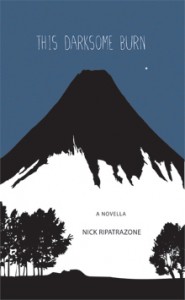 This Darksome Burn
This Darksome Burn
by Nick Ripatrazone
firthFORTH, Forthcoming October 2013
66 pages / More Information
Myth: “This Darksome Burn is a fierce rendition of nature’s obstinate force. Indeed, for one man, toughness and tenacity provide no match for the unpredictable wilderness of the shadowing Siskiyou mountain or his own bereft emotional frontier.” [1]
It’s partially true: Nick Ripatrazone’s new novella begins with Luke camped out in the woods, hunted by a pack of wolves. He has to let his horse free so the wolves will follow it instead of him. When he gets home, tragedy has occurred. He traipses through wailing snow to find the man that raped his daughter, shotgun in hand. Even the cover of the book is a great volcano-like mountain, rising foreboding and dark against the night sky. The wilderness is This Darksome Burn’s setting, as billed. But the really valuable work of the novella is in the juxtaposition between Luke’s “toughness and tenacity” and something less wild: not “his own bereft emotional frontier,” exactly, but the demands of a modern world on a man who has most of his life relied on reticence and grit, virtues of a time that has gone.
It becomes clear, as the novella goes on, that Luke’s wife has died, leaving him in charge of his teenage daughter Aurea and his younger son Ford. Luke knows that he is unequipped. When his daughter is sexually assaulted, all he can think to do is nearly kill the man who has done it, then keep Aurea on house arrest indefinitely. Her concerns are more complicated:
Luke tells Aurea that she still has time. “To tell the police everything.”
“I’m not going to.”
“You protect that bastard. Do you love him?”
“I hate him.”
“Then do it.”
“I’m trying to forget about him.” Aurea closes her hand around Luke’s and looks to the porch. “Can we not do this here?”
And it’s not only with Aurea. Ford, who is longing for something (though it is hard to say quite what), wanders about their acreage, getting into things, and when Luke finds him in the empty barn he knows only how to forbid it, in the same way he has forbidden the stream behind their house:
Though it’s not the horsefly bite Ford is getting ready to cry about. Luke knows that, I think, but doesn’t know how to say it. So what he says and what he does are at odds: he gives Ford a hard time about the hat and the tears, then pulls him close and hugs him. Something in Luke is moving toward expression, toward the knowledge that being tough has stopped working.
Myth: “A tale as deadeye true and magically honest as the language used to tell it. Ripatrazone’s lyric novella will river its way straight to your heart.” [2]
For all its beauty, I don’t think This Darksome Burn is a lyric novella. It is certainly a novella, made up of 41 short-short length sections presented as numbered, discrete units. But I’m not sure the “lyric” designation does justice to the narrative progression of the book. Rarely do Ripatrazone’s words exist solely for their own sake; they’re generally in service of the plot, of character development, of the world in Luke and Aurea and Ford’s backyard. This is a virtue in This Darksome Burn. The story matters.
Though the language is impressive. First of all, in its brevity. The short scenes almost seem to imitate Luke’s own reticence, a symptom of the learned toughness that I see as the central conflict of the novella. Still, passages like this are retained:
The language here feels spare and rich at once. It’s a picture of lyrical consciousness trying to make its way out through words that come slow and few. That is the story of This Darksome Burn: as when the Deputy draws a halting confession from Luke, “Luke has more to say. But not to McDonald.” And maybe not to anybody.
As the novella moves toward a close, perhaps it becomes more lyric. The specter of the nearby stream, which seems somehow to have been related to Luke’s wife’s death, grows closer and more violent. Finally a second tragedy occurs there, occasioned bizarrely by pigs that have escaped from a neighbor’s farm. In the final scene, filled with mud and blood and a pistol held over a dead hog, the book reaches its lyric peak. The characters awake, each with a sentence of their own. Then white space. And the white space feels meant to be.
***
[1] Promotional blurb from firthFORTH Books.
[2] Tom Bailey, author of The Grace That Keeps This World and Cotton Song.
***
Dennis James Sweeney lives in Corvallis, Oregon. Find his work at dennisjamessweeney.com.
Tags: Dennis James Sweeney, nick ripatrazone, This Darksome Burn

Nice nice nice…
tinyurl.com/l3cselt
v